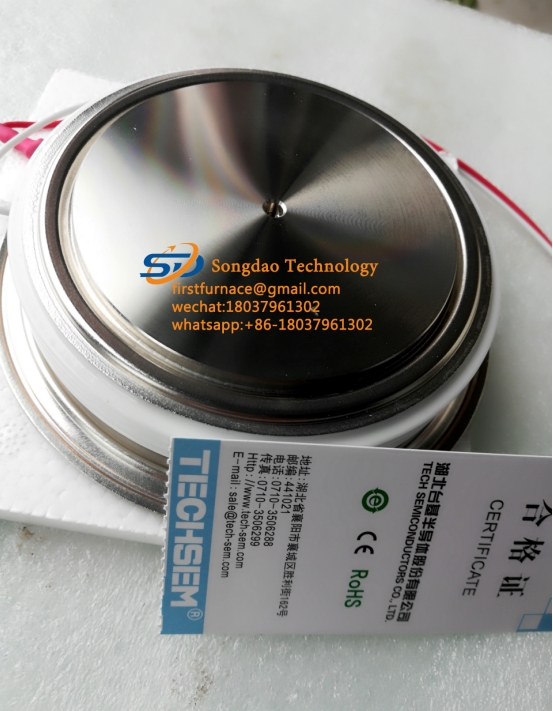- 30
- Sep
အရည်ပျော်မီးဖိုချောင်သုံးဆက်စပ်ပစ္စည်းများ၏အလုပ်လုပ်ပုံနိယာမ: thyristor
induction အရည်ပျော်မီးဖိုချောင်သုံးဆက်စပ်ပစ္စည်းများ working thyristor ၏အလုပ်လုပ်ပုံနိယာမ
လုပ်ငန်းစဉ်များကိ သီရိ T, ၎င်း၏ anode A နှင့် cathode K တို့သည် thyristor ၏ main circuit ကိုဖွဲ့စည်းရန် power supply နှင့် load တို့နှင့်ချိတ်ဆက်ထားသည်။ thyristor ၏ gate G နှင့် cathode K တို့သည် thyristor ကိုထိန်းချုပ်ရန် control circuit ကိုဖွဲ့စည်းရန် device နှင့်ချိတ်ဆက်ထားသည်။ thyristor ။
thyristor ၏အလုပ်အခြေအနေများ
၁။ thyristor သည် positive anode ဗို့အားကိုခံသောအခါ၊ တံခါးအား positive voltage သို့ရောက်မှသာ thyristor ကိုဖွင့်သည်။ ယခုအချိန်တွင် thyristor သည်ထိန်းချုပ်နိုင်သော thyristor ၏ thyristor လက္ခဏာတစ်ခုဖြစ်သည်။
၂။ thyristor ကိုဖွင့်သောအခါ၊ တံခါးအထွက်ဗို့အားမခွဲခြားဘဲ positive positive anode ဗို့အားရှိနေသရွေ့, thyristor သည်ဆက်လက်တည်ရှိနေပါသည်၊ ဆိုလိုသည်မှာ thyristor ကိုဖွင့်ပြီးနောက်တံခါးသည်၎င်း၏လုပ်ဆောင်ချက်ဆုံးရှုံးသည်။ တံခါးသည်ခလုတ်တစ်ခုသာဖြစ်သည်
၃။ thyristor ကိုဖွင့်လိုက်သောအခါ main circuit voltage (သို့မဟုတ် current) သည်သုညနီးပါးသို့ကျဆင်းသွားလျှင် thyristor သည်ပိတ်သွားသည်။
၄။ thyristor သည် reverse anode ဗို့အားကို ၀ န်ခံသောအခါမည်သည့်ဗို့အားကို ၀ င်သည်ဖြစ်စေ၊ thyristor သည်ပြောင်းပြန်ပိတ်ဆို့ခြင်းအခြေအနေတွင်ရှိသည်။
အလယ်အလတ်ကြိမ်နှုန်းမီးဖို၌ rectifier ဘက်မှပိတ်ချိန်သည် KP-60 microseconds အတွင်းရှိပြီး inverter side သည် KK-30 microseconds အတွင်းခဏလောက်ပိတ်ထားသည်။ ၎င်းသည် KP နှင့် KK ပြွန်များအကြားအဓိကကွာခြားချက်လည်းဖြစ်သည်။ Thyristor T သည်ခွဲစိတ်နေစဉ်၎င်း၏ anode ဖြစ်သည်။ A နှင့် cathode K တို့သည် thyristor ၏ main circuit ကိုဖွဲ့စည်းရန် power supply နှင့် load တို့နှင့်ချိတ်ဆက်ထားသည်။ thyristor ၏ gate G နှင့် cathode K တို့သည် thyristor ၏ control circuit ကိုဖွဲ့စည်းရန် thyristor ကိုထိန်းချုပ်ရန် device နှင့်ချိတ်ဆက်ထားသည်။
thyristor ၏လုပ်ငန်းစဉ်ကိုအတွင်းပိုင်းခွဲခြမ်းစိတ်ဖြာခြင်း မှစ၍ thyristor သည်အလွှာသုံးလွှာပါ ၀ င်သောကိရိယာတစ်ခုဖြစ်သည်။ ၎င်းတွင် PN လမ်းဆုံသုံးခု၊ J1၊ J2 နှင့် J3 ရှိသည်။ ပုံ ၁။ အလယ်၌ NP ကို PNP အမျိုးအစား transistor နှင့် NPN-type transistor အဖြစ်ဖွဲ့စည်းရန်အပိုင်းနှစ်ပိုင်းခွဲနိုင်သည်။ ပုံ ၂ thyristor သည် positive anode ဗို့အားကို ၀ င်သောအခါ thyristor သည်ကြေးနီကိုထိန်းညှိပေးသောကြောင့်ပြောင်းပြန်ဗို့အားကိုဆောင်သော PN junction J1 သည်၎င်း၏ပိတ်ဆို့မှုသက်ရောက်မှုကိုဆုံးရှုံးရမည်။ ပုံတွင်ပါသော transistor တစ်ခုစီ၏ collector သည်အခြား transistor တစ်ခု၏ base current လည်းဖြစ်သည်။
ထို့ကြောင့်တစ်ခုနှင့်တစ်ခုပေါင်းစပ်ထားသော transistor circuit နှစ်ခု၌လုံလောက်သော gate current Ig ရှိလျှင်ခိုင်မာသောအပြုသဘောဆောင်သောတုံ့ပြန်ချက်တစ်ခုဖြစ်ပေါ်လာလိမ့်မည်၊ transistors နှစ်ခုပြည့်နှက်သွားပြီး conduction နှင့် transistors များပြည့်နှက်သွားပြီး conduction ဖြစ်လာသည်။ PNP tube ၏ collector current နှင့် NPN tube တို့သည် Ic1 နှင့် Ic2 တို့နှင့်ကိုက်ညီသည်ဆိုပါစို့။ ထုတ်လွှတ်သောလျှပ်စီးကြောင်းသည် Ia နှင့် Ik တို့နှင့်ကိုက်ညီသည်။ current amplification coefficient သည် a1 = Ic1/Ia and a2 = Ic2/Ik နှင့် J2 junction ကို ဖြတ်၍ ပြောင်းပြန်ပြန်လှန်ယိုစိမ့်သော current သည် Ic0 ဖြစ်ပြီး thyristor ၏ anode current သည် collector current အပေါင်းနှင့်ညီသည်။ Ia = Ic1 Ic2 Ic0 (သို့) Ia = a1Ia a2Ik Ic0 ပြွန်နှစ်ခု၏ယိုစိမ့်စီးဆင်းမှု (current current) သည် Ig ဖြစ်လျှင် thyristor cathode current သည် Ik = Ia Ig ဖြစ်၍ thyristor ၏ anode current သည်နိဂုံးချုပ်နိုင်သည်။ : I = (Ic0 Iga2)/(1- (a1 a2)) (1-1) ဆီလီကွန် PNP ပြွန်၏ဆီလီကွန် PNP ပြွန်နှင့်ဆီလီကွန် NPN ပြွန်၏ဆက်စပ်နေသောလက်ရှိချဲ့ထွင်မှုမြှင့်တင်မှု a1 နှင့် a2 တို့သည်လက်ရှိထုတ်လွှတ်မှုနှင့်သိသိသာသာပြောင်းလဲမှုတို့အချိုးကျသည်။ ပုံ ၃ တွင်ပြထားသည်။
thyristor သည် positive anode ဗို့အားကိုခံလိုက်ရပြီးတံခါးသည် voltage နှင့်မသက်ဆိုင်ဘဲပုံသေနည်း (၁) တွင် Ig = 1, (a1 a0) သည်အလွန်သေးငယ်သည်၊ ထို့ကြောင့် thyristor Ia≈Ic1၏ anode current သည် thyristor သည်အပိတ်တွင်အခြေအနေကိုအပြုသဘောဆောင်သည်။ thyristor သည် positive anode ဗို့အားတွင်ရှိနေလျှင်၊ Ig သည်လုံလောက်သော Ig သည် NPN tube ၏ထုတ်လွှတ်မှုလမ်းဆုံမှတဆင့်စီးဆင်းသည်၊ ကန ဦး current amplification factor a2 သည်တိုးလာပြီးလုံလောက်သော electrode current Ic0 သည်ကြီးမားစွာစီးဆင်းသည်။ PNP ပြွန် ၎င်းသည် PNP tube ၏ current amplification factor a2 ကိုတိုးစေပြီး NPN tube ၏ emitter junction မှတဆင့်စီးဆင်းစေသောပိုကြီးသော electrode current Ic2 ကိုထုတ်ပေးသည်။
ဤကဲ့သို့သောခိုင်မာသောအပြုသဘောဆောင်သောတုံ့ပြန်မှုလုပ်ငန်းစဉ်သည်လျင်မြန်စွာလုပ်ဆောင်သည်။
a1 နှင့် a2 သည် emitter current နှင့် (a1 a2) ≈ 1 တို့နှင့်တိုးသောအခါဖော်မြူလာ ၁- (a1 a1) formula 2 သည်ပုံသေနည်း (၁-၁) သို့ရောက်သောအခါ thyristor ၏ anode current Ia ကိုတိုးစေသည်။ ဤအချိန်၌၎င်းသည် thyristor ၏ current ကို main circuit နှင့် circuit resistance ကိုလုံး ၀ ဆုံးဖြတ်သည်။ thyristor သည်ရှေ့သို့ ဦး တည်နေသောအခြေအနေတွင်ရောက်နေပြီ။ ဖော်မြူလာ (၁-၁) တွင် thyristor ကိုဖွင့်ပြီးနောက် ၁- (a0 a1) ≈1သည်တံခါးလက်ရှိ Ig = 1 ဖြစ်လျှင် thyristor သည်မူလ anode current Ia ကိုဆက်လက်ထိန်းထားနိုင်ပြီးဆက်လက်လုပ်ဆောင်သည်။ မရ။
thyristor ကိုဖွင့်ပြီးနောက်တံခါးသည်၎င်း၏လုပ်ဆောင်ချက်ဆုံးရှုံးသွားသည်။ thyristor ကိုဖွင့်ပြီးနောက် power supply voltage ကိုအဆက်မပြတ်လျှော့ချလျှင်သို့မဟုတ် anode current Ia ကို maintenance current IH အောက်ကိုလျှော့ချရန် a1 နှင့် a1 တို့သည်လျင်မြန်စွာကျဆင်းသွားသောကြောင့်၊ thyristor သည် blocking state သို့ပြန်သွားသည်။

